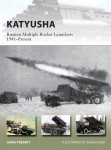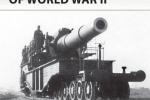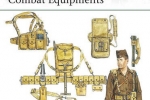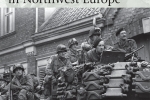Tuesday, February 23, 2016 - 04:56 PM UTC
Osprey is bringing us several new books covering WW2 railroad guns and uniforms/equipment as well as the history of Soviet rocket launchers. For less than $15, these books are full of photos and informative text and provide a good overview of their topics.
Although military rockets have been used since the Middle Ages, it was not until the Soviet Union pioneered the concept of Multiple Rocket Launchers (MRLs), in the late 1930s, that they emerged as a decisive weapon. In the modern era, these Soviet/Russian Katyushas have served in combat in Afghanistan, Chechnya, and Georgia.
Developed to fill the operational need for massed artillery fire support, the MRL possesses enormous destructive power and a devastating psychological impact. This New Vanguard provides a survey of Soviet and Russian Federation MRLs from the beginning of their development in 1938 to the present. It focuses on the history, design, and specifications of self-propelled ground MRL systems, but also covers towed, static, railway, and naval mounts. It highlights the many variants of the principal systems, and includes MRL unit tables of organization and equipment, information on MRL munition types, and coverage of dedicated MRL resupply vehicles.
Discover what equipment a GI carried with him during World War II: what he had strapped around his body, what it contained, and what those items were used for.
In this highly illustrated book, Special Forces veteran Gordon Rottman offers a truly comprehensive treatment of U.S. World War II gear, covering not only basic belts, pouches, and packs, but also mess gear, first-aid gear, tools, bivouac/camping gear--essentially everything that a GI has to keep him alive and operational on the battlefield. Illustrated with wartime photos, new photos of kit from private collections, and color images showing both laid-out kit and half figures of soldiers wearing the gear, this is set to become the primary equipment information resource for anyone interested in the kit and webbing used by U.S. forces from D-Day to Berlin.
Even when Western Allied troops gained a foothold in Normandy, World War II in Europe was far from over. The route to Germany's interior and the Nazis final surrender was long, arduous and blood-stained. The Wehrmacht's stubborn resistance and the shocking losses suffered by US, British, Canadian and 'Free European' troops meant that the Allies had to adapt and refine small-unit tactics, battle-drills, and their use of weapons and munitions. The troops who finally met up with the Red Army in Germany were a very different fighting force to the one that struggled up the beaches of northern France. This book offers a comprehensive guide to the late-war Allied troops, exploring their uniforms, equipment, organization and tactics. Detailed description and accurate color pictures illustrate the means by which the Allied troops on the ground evolved to the point of winning the war on the Western Front.
World War II marked the zenith of railway gun development. Although many of the railway guns initially deployed at the start of the conflict were of World War I vintage, Germany's ambitious development program saw the introduction of a number of new classes, including the world's largest, the 80cm-caliber Schwerer Gustav and Schwerer Dora guns, which weighed in at 1,350 tons and fired a huge 7-ton shell.
This book provides an overview of the types of railway guns in service during World War II, with a special focus on the German railway artillery used in France, Italy, and on the Eastern Front, analyzing why railway guns would largely disappear from use following the end of the war.
Developed to fill the operational need for massed artillery fire support, the MRL possesses enormous destructive power and a devastating psychological impact. This New Vanguard provides a survey of Soviet and Russian Federation MRLs from the beginning of their development in 1938 to the present. It focuses on the history, design, and specifications of self-propelled ground MRL systems, but also covers towed, static, railway, and naval mounts. It highlights the many variants of the principal systems, and includes MRL unit tables of organization and equipment, information on MRL munition types, and coverage of dedicated MRL resupply vehicles.
Discover what equipment a GI carried with him during World War II: what he had strapped around his body, what it contained, and what those items were used for.
In this highly illustrated book, Special Forces veteran Gordon Rottman offers a truly comprehensive treatment of U.S. World War II gear, covering not only basic belts, pouches, and packs, but also mess gear, first-aid gear, tools, bivouac/camping gear--essentially everything that a GI has to keep him alive and operational on the battlefield. Illustrated with wartime photos, new photos of kit from private collections, and color images showing both laid-out kit and half figures of soldiers wearing the gear, this is set to become the primary equipment information resource for anyone interested in the kit and webbing used by U.S. forces from D-Day to Berlin.
Even when Western Allied troops gained a foothold in Normandy, World War II in Europe was far from over. The route to Germany's interior and the Nazis final surrender was long, arduous and blood-stained. The Wehrmacht's stubborn resistance and the shocking losses suffered by US, British, Canadian and 'Free European' troops meant that the Allies had to adapt and refine small-unit tactics, battle-drills, and their use of weapons and munitions. The troops who finally met up with the Red Army in Germany were a very different fighting force to the one that struggled up the beaches of northern France. This book offers a comprehensive guide to the late-war Allied troops, exploring their uniforms, equipment, organization and tactics. Detailed description and accurate color pictures illustrate the means by which the Allied troops on the ground evolved to the point of winning the war on the Western Front.
World War II marked the zenith of railway gun development. Although many of the railway guns initially deployed at the start of the conflict were of World War I vintage, Germany's ambitious development program saw the introduction of a number of new classes, including the world's largest, the 80cm-caliber Schwerer Gustav and Schwerer Dora guns, which weighed in at 1,350 tons and fired a huge 7-ton shell.
This book provides an overview of the types of railway guns in service during World War II, with a special focus on the German railway artillery used in France, Italy, and on the Eastern Front, analyzing why railway guns would largely disappear from use following the end of the war.
Click Star to Rate
4 readers have rated this story.
THIS STORY HAS BEEN READ 8,067 TIMES.
| Osprey Publishing Reviews | MORE |
| The PIAT by Randy L Harvey | of 1 ratings, 100% found this helpful | |
| German Super-Heavy Siege Guns by Randy L Harvey | |
| Glorious Glosters by Randy L Harvey | |
| German Super-Heavy Siege Guns by Randy L Harvey | of 1 ratings, 100% found this helpful | |
| Combat Vehicles of Russia’s SP by kylie newton | |
| Warsaw 1920 by kylie newton | of 1 ratings, 100% found this helpful | |
| Imjin River 1951 by Randy L Harvey | of 1 ratings, 100% found this helpful | |
| The Browning High-Power Pistol by Randy L Harvey | of 1 ratings, 100% found this helpful | |
| Australian Army 1976-2016 by Paul Truhe | of 1 ratings, 100% found this helpful | |
| Verdun 1916 by Randy L Harvey | of 2 ratings, 100% found this helpful | |
| Operation Eagle Claw 1980 by Randy L Harvey | of 1 ratings, 100% found this helpful | |
| Hotchkiss Machine Guns by Randy L Harvey | of 1 ratings, 100% found this helpful | |
| The Arisaka Rifle by Randy L Harvey | of 1 ratings, 100% found this helpful | |
| Division Leclerc by Randy L Harvey | of 1 ratings, 100% found this helpful | |
| Heroes of Telemark by Randy L Harvey | of 1 ratings, 100% found this helpful | |












Comments